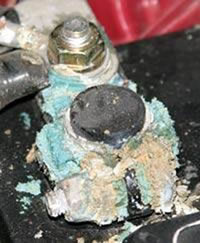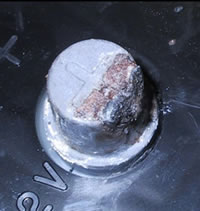Technical info - Terminal corrosion
Terminal corrosion
Corrosion of the metal parts of a battery is the result of a chemical reaction between the terminal and the connections. There are three types of corrosion:
1. Galvanic corrosion
Galvanic corrosion is caused by the potential difference between metals that come into contact with each other, in this case the material of the terminal and the connector. Corrosion generally comes as white lead or zinc crystals or, if the connections are made of aluminium, as aluminium sulphate. Bronze connectors will typically corrode with blue crystals. Very often, the corrosion shows a combination of white and blue crystals: white because of the lead in the connector clip and blue by the purchaser in the cable. This type of corrosion can be prevented by applying a terminal spray or vaseline. If the corrosion has already set in, the terminals and connectors have to be cleaned first. Check for damage: a smooth, sleek surface is important for a good electrical conductivity.
2. Electrolytic corrosion
If the battery contains too much electrolyte, because it has been topped up above the maximum level or in discharged condition, causing the battery’s acid to overflow and come into contact with the terminals and connectors and thus resulting in corrosion. This problem can be prevented by proper battery care.
Lesser known is that the electrolyte may also find its way to the outside through the terminal bushings. Batteries with a side terminal are extra susceptible for this phenomenon called electrolyte creepage.
3. Atmospheric corrosion
Another cause of terminal corrosion can be found in the acid vapor venting out of the battery when reaching full state of charge. This type of corrosion can be prevented by applying a terminal spray or a suitable grease such as Vaseline. If the corrosion has already set in, the terminals and connectors have to be cleaned first. Check for damage: a smooth, sleek surface is important for a good electrical conductivity.

